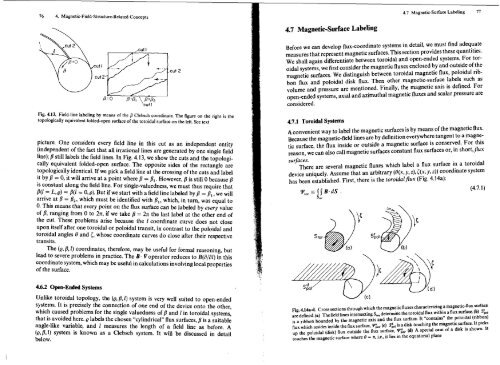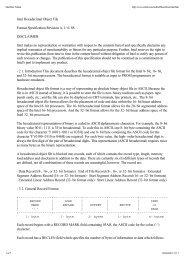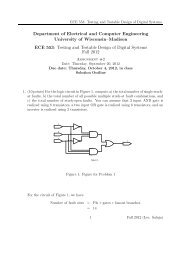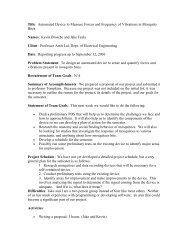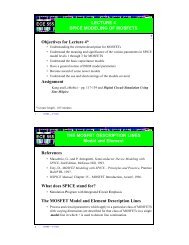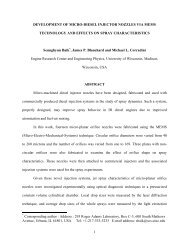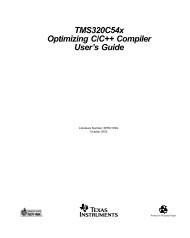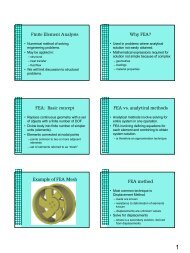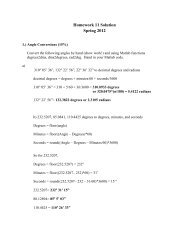Flux Coordinates and Magnetic Field Structure - University of ...
Flux Coordinates and Magnetic Field Structure - University of ...
Flux Coordinates and Magnetic Field Structure - University of ...
You also want an ePaper? Increase the reach of your titles
YUMPU automatically turns print PDFs into web optimized ePapers that Google loves.
76 4. <strong>Magnetic</strong>-<strong>Field</strong>-<strong>Structure</strong>-Related Concepts<br />
Fig. 4.13. <strong>Field</strong>-line labeling by means <strong>of</strong> the Clebsch coordinate. The figure on the right is the<br />
topologically equivalent folded-open surface <strong>of</strong> the toroidal surface on the left. See text<br />
picture. One considers every field line in this cut as an independent entity<br />
(independent <strong>of</strong> the fact that all irrational lines are generated by one single field<br />
line); /? still labels the field lines. In Fig. 4.13, we show the cuts <strong>and</strong> the topologically<br />
equivalent folded-open surface. The opposite sides <strong>of</strong> the rectangle are<br />
topologically identical. If we pick a field line at the crossing <strong>of</strong> the cuts <strong>and</strong> label<br />
it by /? = 0, it will arrive at a point where /? = /?,. However, /.? is still 0 because /?<br />
is constant along the field line. For single-valuedness, we must thus require that<br />
B(1= L, Q) = /?(1 = 0, Q). But if we start with a field line labeled by /? = PI, we will<br />
arrive at p = p,, which must be identified with /?,, which, in turn, was equal to<br />
0. This means that every point on the flux surface can be labeled by every value<br />
<strong>of</strong> /?, ranging from 0 to 2n, if we take /? = 271 the last label at the other end <strong>of</strong><br />
the cut. These problems arise because the I coordinate curve does not close<br />
upon itself after one toroidal or poloidal transit, in contrast to the poloidal <strong>and</strong><br />
toroidal angles 8 <strong>and</strong> [, whose coordinate curves do close after their respective<br />
transits.<br />
The (Q, /?, 1) coordinates, therefore, may be useful for formal reasoning, but<br />
lead to severe problems in practice. The B. Voperator reduces to B(a/al) in this<br />
coordinate system, which may be useful in calculations involving local properties<br />
<strong>of</strong> the surface.<br />
4.6.2 Open-Ended Systems<br />
Unlike toroidal topology, the (Q, /?, I) system is very well suited to open-ended<br />
systems. It is precisely the connection <strong>of</strong> one end <strong>of</strong> the device onto the other,<br />
which caused problems for the single valuedness <strong>of</strong> /? <strong>and</strong> 1 in toroidal systems,<br />
that is avoided here. Q labels the chosen "cylindrical" flux surfaces, /? is a suitable<br />
angle-like variable, <strong>and</strong> 1 measures the length <strong>of</strong> a field line as before. A<br />
(e,/?,l) system is known as a Clebsch system. It will be discussed in detail<br />
below.<br />
4.7 <strong>Magnetic</strong>-Surface Labeling<br />
4.7 <strong>Magnetic</strong>-Surface Labeling 77<br />
Before we can develop flux-coordinate systems in detail, we must find adequate<br />
measures that represent magnetic surfaces. This section provides these quantities.<br />
We shall again differentiate between toroidal <strong>and</strong> open-ended systems. For tor-<br />
oidal systems, we first consider the magnetic fluxes enclosed by <strong>and</strong> outside <strong>of</strong> the<br />
magnetic surfaces. We distinguish between toroidal magnetic flux, poloidal rib-<br />
bon flux <strong>and</strong> poloidal disk flux. Then other magnetic-surface labels such as<br />
volume <strong>and</strong> pressure are mentioned. Finally, the magnetic axis is defined. For<br />
open-ended systems, axial <strong>and</strong> azimuthal magnetic fluxes <strong>and</strong> scalar pressure are<br />
considered.<br />
4.7.1 Toroidal Systems<br />
A convenient way to label the magnetic surfaces is by means <strong>of</strong> the magnetic flux.<br />
Because the magnetic-field lines are by definition everywhere tangent to a magne-<br />
tic surface, the flux inside or outside a magnetic surface is conserved. For this<br />
reason, we can also call magnetic surfaces constant flux surfaces or, in short,flux<br />
surfaces.<br />
There are several magnetic fluxes which label a flux surface in a toroidal<br />
device uniquely. Assume that an arbitrary (B(x, y, z),((x, y, z)) coordinate system<br />
has been established. First, there is the toroidalflux (Fig. 4.14a):<br />
ng.4.14a-d. Cross sections through which the magnetic fluxes characterizing a magnetic-flux surface<br />
are ddned.(a) The W lines intersating determine the toroidal flux within a flux surface (b) Sj<br />
is a ribbon bounded by the magnetic axis <strong>and</strong> the flux surface. It "contains" the poloidal (ribbon)<br />
flux which resides inside the flux surface, YL,. (c) S&, is a disk touching the magnetic surface. It picks<br />
up the poloidal (disk) flux outside the flux surface, Y&. (d) A special case <strong>of</strong> a disk is shown. lt<br />
touches the magnetic surface where 0 = n, i,e., it lies in the equatorial plane


